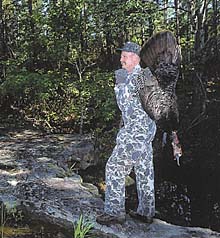|
|
 |
 |
Turkeys Eastern Style |
|
Scouting
Burk says he'll scout private lands differently than public lands. On private lands, where hunter numbers and locations are known, he'll scout the obvious places known to hold concentrations of birds-unfragmented creek drainages and fairly open hardwood bottomlands located adjacent to upland pine stands. He looks for similar geographics on public lands, but tends to favor areas that are off the beaten path. "Turkeys that get lots of pressure get smart real quick," Burk comments. "For that reason I try to hunt low-pressure areas on public lands-places that are not easily accessed. You can find these by looking at a map that shows where all the roads and creeks are. You might have to hike into an area to find out if he's there. But if he is, you'll more than likely have him all to yourself when the season opens." Setting Up "Setting up properly is much more important than being a national turkey calling champion," Burk continues. "I've seen some really poor callers take Eastern turkeys consistently, mainly because they are good woodsmen. They know where to go and how to set up properly on the birds when they get there. "When you hear a gobbler," he says, "try to get in as close as possible without spooking him before you start calling-about 100 yards or so. Then, set up in such a manner that it makes it as easy as possible for the gobbler to get to you. I call it setting up in `the path of least resistance.' "Whenever possible, try to set up in a place where the gobbler won't have to cross a creek, fencerow or come through really thick cover. Ideally, you want fairly open woods between you and the bird, with little or no obstacles that might cause him to hang up." Burk also advises setting up in a place where you won't be able to see the bird until it comes within shooting range. A logging road intersection, small opening or food plot surrounded by woods or the base of a ridge are among some of the better locations. The ideal vantage point might be at the base of a large hardwood, a fallen tree or lying facedown in tall grass or brush. Calling Tips "Don't call too much," Burk cautions. "Turkey hunting in the spring is a complete reversal of nature in that the hen is supposed to go to the gobbler. The more calling you do, the more you're sending the message that he ought to be waiting for the hen instead of actively seeking her out. "The rule of thumb is to call as little as it takes to get the bird into range. If I throw out a soft yelp and a gobbler answers, oftentimes that'll be the last call I'll make. A gobbler has to stop every time he gobbles, after which he does his little strutting dance. So theoretically, every time you get him to gobble, you're slowing him down. And the more you slow him down, the more likely he is to hang up. "The only time a hunter should call aggressively is when he knows the gobbler is with hens. The idea here is to seduce him away from the other hens or call the other hens to you. If the hens come, he'll come in tow." Camo/Movement "Turkeys are not like deer," concludes Burk. "You can sit perfectly still and a deer probably won't see you no matter what you're wearing. But a turkey will peg you. "Dress in full camo head-to-toe with a face mask and gloves. Camo that matches the area is highly preferred. Something like Trebark or Realtree Advantage meshes really well with our surroundings in East Texas. "When you move on a turkey, his head has to be 100 percent concealed behind a tree or his fan. If you can see a turkey's head and try to make a move, no matter how slow, he'll peg you and leave. It's a hard lesson to learn, but turkeys are not very curious."
|
|
|
| Site design by Outdoor Management Network Inc. Copyright © 1996-2007 Outdoor Management Network Inc. America Outdoors® is a registered trademark of Outdoor Management Network Inc. |
 "One of the big keys to killing Eastern birds consistently is locating them. And," Burk notes, "the best period
to do that is the last week of March and the first week of April.
That's when the birds are going to be most vocal, and the majority
of gobblers out there are going to be screaming. If you locate
a gobbler before the season, he'll more than likely be in that
same area once the season opens, if he's not disturbed."
"One of the big keys to killing Eastern birds consistently is locating them. And," Burk notes, "the best period
to do that is the last week of March and the first week of April.
That's when the birds are going to be most vocal, and the majority
of gobblers out there are going to be screaming. If you locate
a gobbler before the season, he'll more than likely be in that
same area once the season opens, if he's not disturbed."